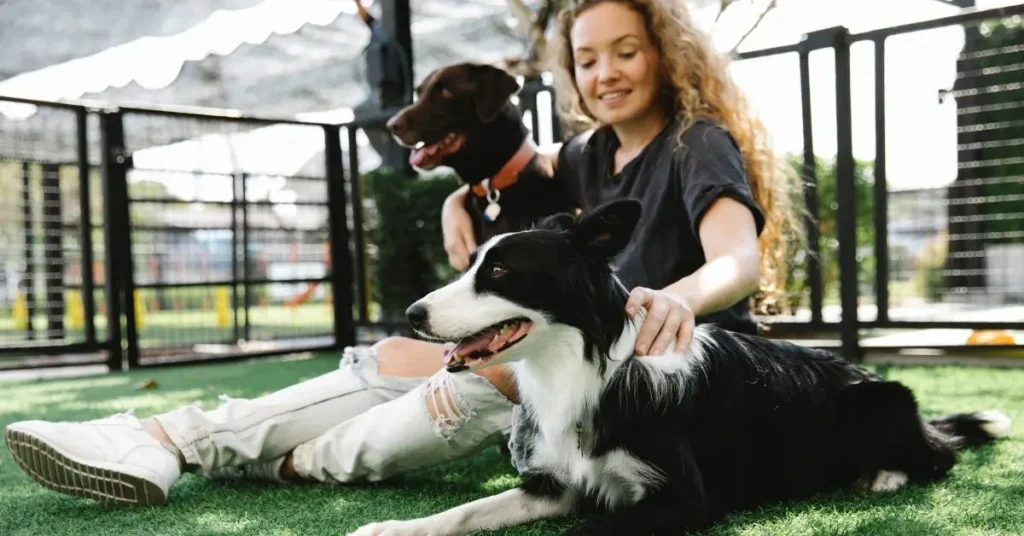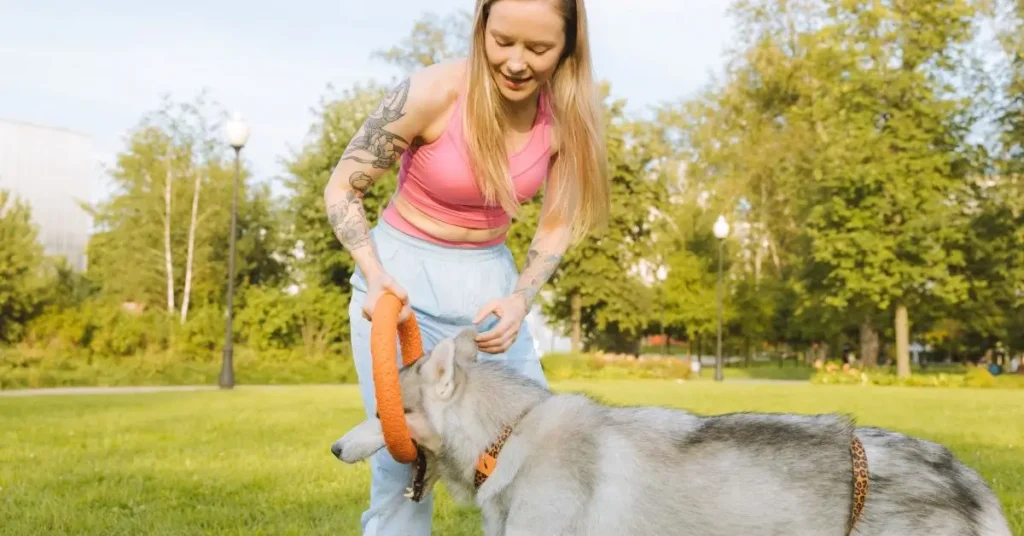What is DPT Dog: Have you ever wondered why you wake up so calm and relaxed when sleeping with a heavy blanket? You’re not alone, many people sleep better and wake up less stressed when using weighted blankets.
Table of Contents
ToggleThis is known as deep pressure therapy (DPT). It’s a calming technique in which applying pressure on the human body promotes relaxation and calmness. Nowadays, people use their dogs’ mass to apply that pressure. The dogs trained to do this technique are known as DPT dogs.
In this article, we’ll discuss deep-pressure therapy and how to teach your dog to do it.
What Is a DPT Dog?
Deep pressure therapy is an alternative or complementary therapy that involves the application of gentle, firm pressure to the body. There are various ways to apply pressure, including hugging, squeezing, swaddling, and holding.
You might be asking what’s the point of deep pressure therapy. To answer this, we need to take a closer look at our nervous system.
The nervous system is the body’s control center; it regulates all our body functions by receiving signals from different body parts and sending back signals to tell our body how to respond to various stimuli.
Our autonomic nervous system consists of two main parts: the sympathetic and the parasympathetic nervous system.
The parasympathetic nervous system controls the body’s involuntary movements, such as the heart rate, breathing rate, blood pressure, and bowel movement. Stimulating the parasympathetic system shifts your body to a state of calmness and relaxation.
On the other hand, the sympathetic nervous system controls the body when it’s in danger, or what’s known as the fight-or-flight response.
It’s believed that deep pressure therapy increases parasympathetic activity and decreases sympathetic activity. As a result, it helps reduces stress and anxiety levels shifting our body to a state of relaxation.
What Does Psd Stand for Dogs?
PSD stands for psychiatric service dogs. These dogs are trained to aid people with mental illnesses or disabilities in performing their daily tasks.
They’re treated as service dogs, meaning they can accompany their handler in areas where pets aren’t allowed. They can be in any shape, size, or breed as long as they’re trained properly.
What Is a Tactile Stimulation Service Dog?
Tactile stimulation service dogs are trained to provide tactile stimuli to their owners by licking, nudging, and playing with toys. These dogs also help their handler with finding lost items.
Large-sized dogs often perform tactile stimulation by rubbing their chin on different parts of their handler’s body.
How Do You Teach Deep-Pressure Therapy?

DPT dogs must be well-trained to provide therapeutic pressure to their handler when needed. Still, they don’t require a professional to train them. Many dog owners train their dogs on their own, it might take time and effort, but it’s worth it.
You can teach your dog to apply deep pressure in various ways. For example, some teach their dog to sit and apply pressure on their lap.
Others prefer teaching their dog to lie on their chest. Before you choose the best technique for you, let’s start with some fundamentals you need to teach your dog.
1. Teach Your Dog to Be Comfortable on Uneven Surfaces
This is extremely important if you want your dog to provide pressure by sitting on your chest. Many dogs might feel uncomfortable stepping on uneven surfaces like cushions, steps, or your chest.
The main point here is to teach your dog to follow the normal obedience orders like sit, down, or stay on uneven surfaces (cushions or steps).
2. Make Sure Your Dog Has a Solid Down-Stay
Your dog needs to have a solid durational down-stay. Teaching your dog to follow down or stay commands is pretty easy. However, it’s challenging to get him to stay for a long time.
3. Teach Your Dog to Go to a Place
This is a handy technique to teach your dog to DPT. Why? Because it works on the dog’s body position, which is essential in DPT. For example, you can teach your dog to lie on his mat.
Once your dog gets used to his mat, you can transfer it anywhere else and order him to lie on it. Ultimately, you can put the mat on your body and get your dog lying on it in a suitable position.
4. Teach Your Dog to Chin Rest
Chin rest is when your dog rests his chin in your hand. You can teach him to do so by putting one hand under his chin, letting his chin rest, then rewarding him with the other hand until he masters this order.
In DPT, you can use the chin rest order to let your dog rest his chin on your arm or knee, which is beneficial in applying pressure.
How Do I Teach My Dog to DPT?

The teaching process might differ depending on the dog’s breed, size, and the amount of pressure you want. However, we’ll provide you with the techniques your dog needs to master after learning the basic orders.
1. Teach Your Dog to Sit On Your Lap/Chest
You can train your dog to sit and apply pressure on your lap using his upper body or lie on your chest. Depending on your dog’s size you want to choose one method to focus on first.
For large dogs, it’s better to start teaching them how to apply pressure on your lap. For smaller dogs, it’s better to train them to use their whole body to apply deep pressure on your chest.
- Start this training by sitting on the ground or couch.
- Get your dog’s mat and put it on your body.
- Order your dog to get on the mat and lie on it using the ‘down’ order.
- You can choose a word like ‘lap’ to motivate your furry friend to start this task.
- Use food and treats as a motivation to adjust your dog’s position.
- Once your dog is in the correct position, reward him with treats.
- Use the chin rest command and let your dog use his chin to apply pressure on your arm or chest, then reward him again.
- Finally, use a release word like ‘free’ or ‘go’ to release your dog from his position.
The most critical part of this training is to get your dog lying in a proper position every time. To do this, avoid using the couch every training session. Instead, repeat the same training steps on different surfaces like a bed or the floor.
Also, start rewarding him only when he’s in the correct position. That way, he gets used to sitting in that position regularly.
2. Increasing the Duration of the Training Session
Once your dog learns how to lie down properly on your body, it’s time to keep him sitting for longer periods without giving him treats.
Start by spacing out the rewards you give him and continue with the same rules. You can also give him more treats if he responds faster to your orders or when he lies correctly.
3. Performing the Task Without the Mat
If you’re using a word command such as ‘go to place’ to get your dog sitting on the mat, you need to replace it with a new command so that your dog learns to perform DPT without the mat.
To do this, use a new word such as ‘DPT’ or ‘Hug.’ Then, use the same old word, when your dog responds, reward him, and so on.
Now it’s time to get rid of the mat; you can do this by folding it in half. After that, give your dog the same orders and see how he positions himself. If he lies in the correct position multiple times, you can finally get rid of the mat.
The last thing you want to do is to teach your pup to perform the task without getting distracted. To do this, change your location every training session; for example, use your car seat.
Start adding distractions like shaking your legs; as long as your dog isn’t distracted, reward him with treats.
4. Choosing the Right Dog Breed
You can’t train any dog type to help in DPT. Similar to service dogs, not all dog types make good service dogs. For instance, small-sized dogs can’t provide enough pressure. Also, short-tempered dogs might be harder to train.
Conversely, dog breeds like Golden Retriever, Labrador Retrievers, Collie, and Bernese mountain make great DPT dogs.
What Does DPT Help With?
DPT reduces stress hormones such as cortisol, which decreases anxiety and depression.
Furthermore, DPT helps patients with chronic mental diseases such as depression, autism, insomnia, PTSD, SPD, ADHD, and Tourette’s syndrome.
What is a deep pressure therapy dog?
A deep pressure therapy (DPT) dog is a type of Psychiatric Service Dog that uses the Deep Pressure Therapy technique to alleviate psychiatric symptoms, typically as a calming strategy or to reduce disengagement from the world. This tactile stimulation is delivered to the body through gentle pressure such as tugging, stroking, cuddling, or wrapping. It can be used to self-harm by applying pressure to the affected body part.
What is deep pressure therapy used for?
Deep Pressure Therapy (DPT) is a type of tactile sensory input that gives the body proprioceptive feedback. It stimulates the parasympathetic nervous system, resulting in a sense of calm and contentment Occupational therapists have used DPT to help people with autism spectrum disorders (ASD).
How much does a deep pressure therapy dog weigh?
Deep Pressure Therapy (DPT) dogs are specially trained psychiatric service dogs that aid in the treatment of autism, PTSD, and ADHD. They can weigh up to 115 pounds and require more than basic obedience training. Training for public access is critical and should be done gradually.
How long until a therapy dog is fully trained?
Therapy dog training typically takes 6-8 weeks of professional training or approximately two years of self-training. During this time, the dog is taught basic obedience as well as skills specific to their disability. Finally, the dog must be certified by a reputable national organization with trained therapists and specialists.
How long does it take to make your dog a therapy dog?
Training a therapy dog typically takes 6-8 weeks, though it may take longer depending on the individual dog. Basic obedience and control should be taught, as well as passing the Canine Good Citizen test. In addition, for AKC certification, the dog must be friendly and have completed 50 visits with staff signatures. It can take up to two years to train a service dog.
Why do dogs do DPT?
Deep pressure therapy (DPT) is performed by dogs to provide emotional and psychiatric support to their handlers. DPT is a task taught to Psychiatric Service Dogs that involves applying weight and warmth to the handler. This can help people who are stressed, depressed, or experiencing flashbacks relax. It is similar to a weighted blanket for autistic people.
Can therapy dogs sense sadness?
According to research, dogs can detect depression and respond lovingly to their owners in an attempt to cheer them up. When their owners are experiencing negative emotions, dogs have been observed displaying sympathy and empathy. Because of their sensitivity to human emotion, therapy dogs have been used to reduce student stress and anxiety.
To Sum Up the Question: What is DPT Dog
Deep pressure therapy (DPT) dogs are another option for those seeking physical and emotional relief. Studies demonstrated that the presence of a calm friendly dog on your lap/chest can decrease stress hormone levels, and increase the feelings of safety and relaxation.
This can be helpful for people who have difficulty sleeping because of stress or anxiety. Additionally, DPT helps with many mental illnesses, such as autism, ADHD, and depression.








